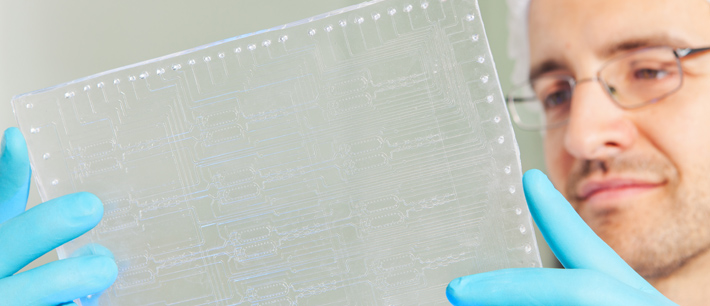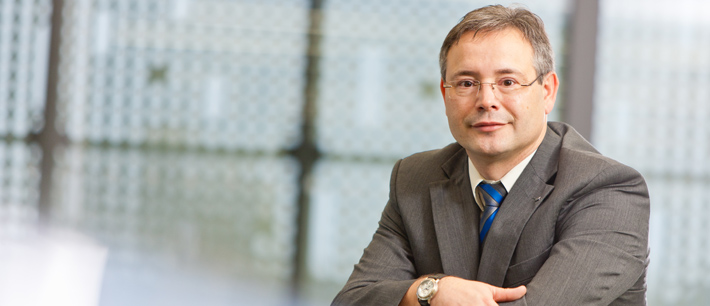- Silicon Nanowire Path
- Carbon Path
- Organic / Polymer Path
- Biomolecular-Assembled Circuits
- Chemical Information Processing Path
- Orchestration Path
- Resilience Path
- CRC 912 (HAEC)
- Biological Systems Path
Path E - Chemical Information Processing

The Chemical Information Processing Path (CIP) uses chemical properties of substances (composition, physical state, concentration, etc.) as carriers of information. The unconventional approach is to process this chemical information in a controllable, integrated, massively parallel, microfluidic environment with various functional composition elements. Implemented with CMOS, this technology has the potential to revolutionize many processes involving feedback loops of chemical information (e.g., the synthesis of matter with designed properties) that are nowadays slow and manual and in doing so, open up completely new application domains.

Prof. Dr. Andreas Richter
Path Leader: Prof. Dr. Andreas Richter
Path Co-Leader: Prof. Dr. Brigitte Voit
- Prof. Dr. rer. nat. Johann W. Bartha
- Prof. Dr. Stefan Diez
- Dr. Martin Elstner
- Prof. Dr. rer. nat. habil. Alexander Eychmüller
- Prof. Dr. Christof Fetzer
- Prof. Dr.-Ing. habil. Gerald Gerlach
- Prof. Dr. rer. nat. habil. Rainer Jordan
- Dr. Frank Jülicher
- Prof. Dr.-Ing. habil. Christian Georg Mayr
- Prof. Dr. rer. nat. et Ing. habil. Michael Mertig
- Prof. Dr. Andreas Richter
- Prof. em. Dr.-Ing. habil. René Schüffny
- Prof. Dr. rer. nat. habil. Stefan Siegmund
- Prof. Dr. Jens-Uwe Sommer
- Prof. Dr. Brigitte Voit
The Path aims to advance electronics by implementing a new functionality: the processing of chemical information. Looking to nature, we note that CIP with implemented decision-making, selection processes and adaptability to unpredictable events are basic principles (related to CIP) in reproducing and further developing the incredible diversity of life. Breaking it down to the comparably simple task of developing a retro-synthetic approach of a single complex natural chemical substance, the enormous effort involved becomes clear: the task requires
- a multitude of individual reaction steps each in need of reaction condition optimization;
- decisions determining in which direction to further proceed;
- extensive brain and man power to combine scientific knowledge,
- and knowledge-based decision making with labor and time intensive experiments with often unpredictable outcomes.
A perfect tool to overcome these limitations would be a technical platform that processes chemical information in the form of matter figuratively comparable with today’s microprocessors processing electronic information. A highly integrated CIP chip could perform not only hundreds or thousands of chemical reactions simultaneously, but would also provide the capabilities to perform the analysis tasks as well as the required decision making by means of integrated closed loop control mechanisms, e.g., with chemical transistors combining both chemical sensor and actuator properties in a single component.
Such systems have the potential to reduce the processing time from years to days, and are able to minimize the consumption of energy and chemicals, and drastically improve the reliability of the processes. Furthermore, the above-indicated natural CIP networks have a robust performance, which includes complex trade-offs between energy requirements, transport efficiency, and fault tolerance. Utilizing the underlying principles of a CIP chip, we could generate a tool capable of optimizing the balance of cost, efficiency, and resilience for critical transport problems of natural or designed complex networks. This may enable the exploitation of complex biological processes to a much greater extent, such as in the case of resource scarcity or disasters.
From a general point of view, the ideal CIP “microprocessor” consists of an active polymer substrate comparable with active silicon substrate-based microprocessors, which interact with the information carrier “electronic charge”. In CIP, an active-substrate material is required capable of interacting with an information carrier such as substance concentration. The only realistic microfluidic active-substrate platform is based on stimuli-responsive hydrogels. These exceptional materials are in a critical swelling equilibrium, which depends on the free enthalpy of mixing polymer network and swelling agent, and the elasticity of the polymer chains (Flory-Rehner theory). Even small changes in environmental parameters, e.g., small changes of a certain solvent concentration, can lead to a so-called volume phase transition, which is a drastic change of the swelling degree of the hydrogel.
The only working hydrogel-based microsystems platform originates from Dresden and has been developed as result of the former collaborative research center, SFB 287 ”Reactive Polymers“. We have created a wide range of microfluidic basic components including microvalves, micropumps and chemical sensors. Furthermore, we have successfully developed a fabrication technology to monolithically integrate thousands of hydrogel-based components into the microchip by using UV lithography and created principles to electronically control each of the thousands of components individually.
Our concept is the only other LSI technology besides micropneumatics suitable for microfluidics. Unlike micropneumatics however, our active-substrate systems are able to interact autonomously with chemical information. As an essential prerequisite for the CIP, we invented two basic types of chemostat valves (chemical transistors), which combine the characteristics of actuator and chemical sensor. In contrast to electronic transistors, chemical transistors regulate a liquid flow depending upon a special concentration with the concentration threshold being adjustable e.g., by temperature control.
The response time of hydrogel-based microfluidic components is in the range of hundreds of milliseconds to a few seconds and complies with the time requirements of diffusion-based reactions. Long-term expertise in the field of synthesis and functionalization of hydrogels, their use in MEMS, chemical sensors and material modeling exists in Dresden.
This preliminary work is the fundament of the current Path and creates the physical, material and theoretical base of an active-substrate microprocessor platform for chemical information processing. The Path is divided into four Research Modules (see table). It integrates the expertise of the new Strategic Professor Adaptive Networks (SP AN). Furthermore, a new RGL Chemical Information Processing Systems will be created for exploring CIP from the device level up.
The world's first Chemical Microprocessor
- TU Dresden Press Release (in German only)
- Article released - DOI: 10.1039/C2LC40617A
cfaed Publications
Sample solution constraints on motor-driven diagnostic nanodevices
Reference
Slobodanka Korten, Nuria Albet-Torres, Francesca Paderi, Lasse ten Siethoff, Stefan Diez, Till Korten, Geertruy te Kronnie, Alf Månsson, "Sample solution constraints on motor-driven diagnostic nanodevices", In Lab on a Chip, Royal Society of Chemistry, vol. 13, no. 5, pp. 866–876, 2013. [doi]
Bibtex
title={Sample solution constraints on motor-driven diagnostic nanodevices},
author={Korten, Slobodanka and Albet-Torres, Nuria and Paderi, Francesca and ten Siethoff, Lasse and Diez, Stefan and Korten, Till and te Kronnie, Geertruy and M{\aa}nsson, Alf},
journal={Lab on a Chip},
volume={13},
number={5},
pages={866--876},
year={2013},
publisher={Royal Society of Chemistry},
doi={10.1039/C2LC41099K}
}
Downloads
No Downloads available for this publication
Related Paths
Chemical Information Processing Path
Permalink
https://cfaed.tu-dresden.de/chemical-information-processing?pubId=354





